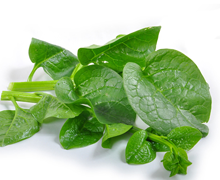
- Address : P.O. Box 11, Gannoruwa rd, Peradeniya, Sri Lanka
- E- Mail : director.hordi@doa.gov.lk
- Telephone :(+94) 081-2388011-12-13
- Fax :(+94) 081-2388234

Niwithi
Spinacia oleracea
A green leafy vegetable rich in Iron. It contains oxalic acid which prevents the body from absorbing Calcium. Therefore, the calcium in the blood is not absorbed into the bones and may accumulate in the kidneys and bladder and deposited there.
Available Types
There are two types of spinach, erect type and vine type, depending on the growth habit. Large leafy vines are used for cultivation. There is a red spinach type that is edible. It’s not so popular.
- Large vine type with green leaves (giant spinach)
- Red spinach
Climatic requirements/ Areas suitable for cultivation
Can be grown in any part of Sri Lanka except in low temperature regions
Soil
Spinach needs well-drained places for cultivation.
Seed requirement
10 – 15 grams of seeds is required per 10m2 bed. (10-15g / 10m2 bed)
Field preparation and planting
Weeds should be controlled and the ground should be ploughed well and the soil should be finely prepared. It is important to improve drainage by placing raised beds in areas where water logged. It is advisable to plant two seeds in one place. It takes about 5-6 days for the seeds to germinate.
Planting material
Seeds are used for planting. Although cuttings can be used for planting, the early flowering will retard the growth of the plant. Therefore cuttings are not recommended as planting materials.
Providing support
If the cultivation is going on for a long time, 4 weeks after planting, prepare a trellis about 1 – 1 1/2 feet above the ground level.
Spacing
Erect type- The spacing between rows and the within rows is 15cm x 15cm.
Vines – 45cm between rows 45 cm within rows
Seeds and seedlings are used for planting.
Fertilizer
Organic fertilizer
Poultry manure is widely used. Although cattle manure is more suitable, it increases the chances of weed growth. It can be used in home gardening. 25 kgs of poultry manure can be applied for 10m2 bed. (25kgs/ 10m2) It is advisable to mix organic manure with the soil, few days before planting the seeds.
Chemical fertilizer
The amount of fertilizer to be applied per 100 square meters of land
Fertilizer application | Urea kg. | TSP kg. | MOP kg. |
Basic fertilizer | 1.0 | 1.5 | 1.0 |
2–3 weeks after planting | 1.0 | – | – |
Note 1: It is advisable to apply phosphorus and potassium as basic fertilizers after a soil test.
Water supply/Irrigation
Irrigate the crop well every 3-4 days. In dry weather it is advisable to irrigate the crop more often without allowing them to wither.
Weed Management
Weeds should be removed and the field should be kept clean as long as the crop remains.
Pest Management
Disease Management
Causal Organism: colletotrichum spinaciae
Symptoms
- In initial stage – Small , circular water – soaked lesions on both young and old leaves
- In late stage – Lesion turns brown to brownish color and become thin and papery , Tiny black fruiting bodies (Acervuli) from profusely in diseased tissue and are a characteristic feature
Management
- Removal of diseased plant debris from the filed
- Establishment of suitable drainage systems
- Sprinklers can be caused to increase spreading of disease, due to this reason it is suitable to use another favorable water supply system
Causal Organism: Pseudomonas syringae pv.spinaciae
Symptoms
Initial symptom is consist of water –soaked irregulory shaped spots that measure 0.12 -0.25 inch in diameter. As the disease develops they enlarge as much as 0.5 -0.75 inch in diameter, are angular and turn dark brown in color. Occasionally spots have block sections or edges. Sometimes these spots merge together and resulting the death of large areas of leaves can be seen in both newly expanded and mature foliage
Management
- Removal of affected leaves
- Don’t use sprinkler irrigation system
Causal Organism: cladosporium variabile
Symptoms
Rarely exceed spots 0.25 inch in diameter. They are round and tan in colour. In final stage can be seen holes
Management
Treatment is rarely needed. Copper fungicides can be used when needed.
Causal Organism: Fusarium oxysporum, phythium spp, rhizoctonia solani
Symptoms
In nursery period wilting of seedlings and death of seedlings can be caused due to root rot.
Management
- Can be control by seed treatments, sterilization of nurseries and water management
- Application of fungicide if necessary
Harvesting
Harvesting can be done in two ways.
- After about 40-50 days, the seedlings are removed and taken as a harvest.
- After about 40-45 days, cut the upper part of the stem to a height of about 15 cm from the ground level and allow the bushes to grow again and harvest about 6-8 times.
Harvest
1000 – 1500 kg per square meter. (1000-1500 kg / m2)
